Students should know that sulfuric acid can act in three main ways: as an acid, an oxidising agent and a dehydrating agent.
Demonstrations of the dehydrating properties of sulfuric acid are commonly given to audiences of 16–18 year olds (and to younger audiences for their visual appeal). Previously we looked at the most popular of these1 in which sulfuric acid dehydrates sucrose, causing a black carbon ‘snake’ to rise from the reaction vessel. The production of sulfur dioxide fumes indicates that oxidation processes also occur.
A less common demonstration involves the dehydration of permanganic acid (HMnO4). This is produced in the acid-base reaction of potassium manganate(VII) (KMnO4) with sulfuric acid. The resulting manganese(VII) oxide (Mn2O7) reacts violently with organic compounds and this can be shown through its action on cotton wool.
Kit
- 2 cm3 concentrated sulfuric acid (corrosive, oxidising)
- 1 g KMnO4 (irritant, oxidising)
- 2 watch glasses
- White tile
- Heat resistant mat
- Cotton wool ball (c.2 cm3)
- Glass rod (c.30 cm long)
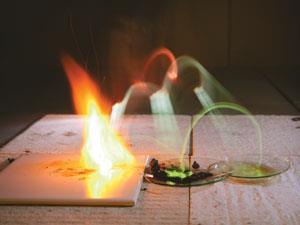
Preparation
Work in a well-ventilated room. Place two watch glasses on a heat resistant mat. To the first add 2 cm3 of concentrated sulfuric acid (corrosive, oxidising). Add a spatula of KMnO4 (irritant, oxidising) to the other. Place the cotton wool ball on a white tile next to the heat resistant mat.
In front of the audience
Use a long glass rod (approximately 30 cm) to distance yourself from the reaction. Dip the end of the rod in the acid to collect a drop, touch the KMnO4 then immediately touch the resulting mixture onto the ball of cotton wool. After a few seconds the ball will ignite from the point where the Mn2O7 has been generated and burn away.
A small amount of MnO2 fumes may be produced, as the Mn2O7 is reduced in the reaction. However at this scale the use of a fume cupboard is not required.
Disposal
Disposal must be done immediately following the demonstration. Wait until all the reactions are complete before placing any materials that have come into contact with KMnO4 into a large bowl of water. Any unreacted Mn2O7 will be immediately hydrolysed to HMnO4 and diluted. The solution can be disposed of down the sink with plenty of water.
Teaching goal
As soon as the acid comes into contact with the KMnO4, small amounts of Mn2O7 are produced. The focus of the demonstration should be on the action of the acid.
Initially the sulfuric acid acts as an acid, protonating the MnO4– ion to form HMnO4:

For those who have already covered acid-base chemistry, this presents an opportunity to discuss the conjugate acid-base pairs. KMnO4 is a very poor base, the salt of a strong acid. KHSO4 again is an extremely poor base, the salt of a strong acid. Some basic manipulation can be used to calculate the equilibrium constant for the reaction.
Firstly, write out the acid dissociation expressions:

and

However the second reaction is happening in reverse – the chemical equation is written such that the equilibrium constant for the protonation of MnO4– is in fact the reciprocal: 1 / 10–(–2.5)
Combining the two equilibria we find that:

Students should be able to see that, under standard conditions, the equilibrium lies to the right when K is greater than 1.
By the laws of logarithms, this calculation can be done more simply by working out K in one easy step as 10–(–2.5–(–3)). However those less mathematically inclined will not necessary see how this expression was derived.
Using ΔG = –RT ln K, it can be shown that the reaction would have an associated free energy of –7.8 kJ mol–1 and is predicted to be spontaneous.
The HMnO4, once formed, is extremely unstable and undergoes dehydration in a second reaction with sulfuric acid to form the required Mn2O7:
2HMnO4 → Mn2O7 + H2O
The Mn2O7, a drop of dark green oil, forms in situ on the end of the glass rod. As soon as it comes into contact with the cotton wool, it aggressively oxidises the cotton wool causing it to ignite and burn rapidly. The compound is particularly unstable at room temperature and it is likely that some of the reaction seen is as a result of its decomposition.
Safety
- Mn2O7 is corrosive, explosive and oxidising. Wear a face shield or goggles.
- The reaction produces fumes containing MnO2: work in a well-ventilated room.
- Protect the audience and demonstrator with safety screens.
- Do not attempt with other organic substances as many react more violently.
- Do not attempt this at a larger scale.
References
- Education in Chemistry, March 2007, p42 (http://rsc.li/1cRDiz1)




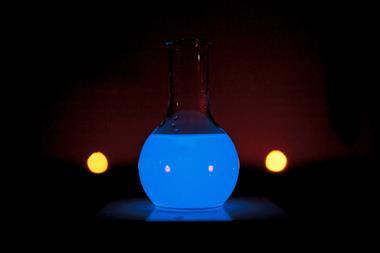
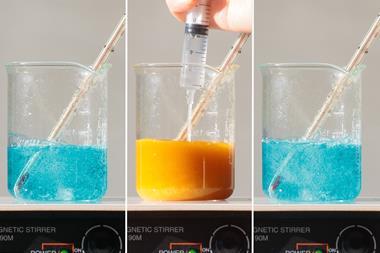
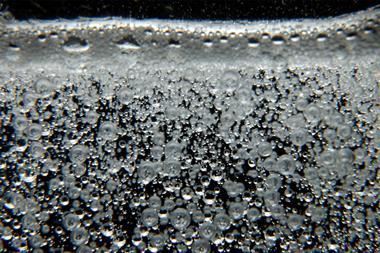
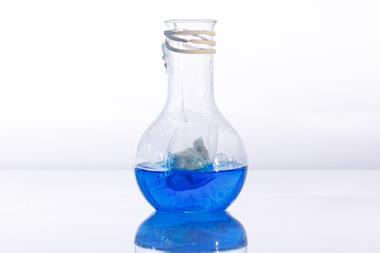
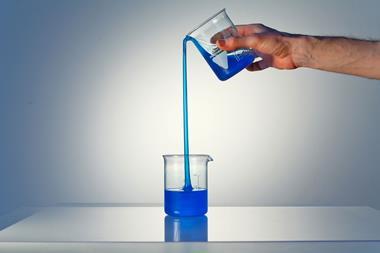








No comments yet